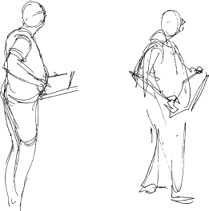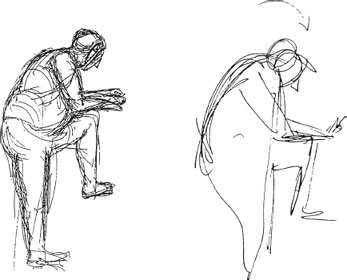I’ve been aware of how you all treat your pencils and pens as if they were precious instruments through which your inmost thoughts may be expressed. You gently urge the image onto the paper with a tenderness that suggests a personal affection for the whole process of drawing. You see musicians display that kind of emotional attachment to their instruments. Classical guitarists hug their instruments and manipulate their fingers along the strings as if they were caressing them. Pianists do the same (except you can’t hug a piano). I’ve seen them work their fingers on a key as if trying to get a vibrato out of the instrument like a violinist does. No way is this possible, but the feeling is there and that is an important part of playing the piano.
I have a piano instruction book with the delightful title, Pumping Ivory, by Robert Dumm. In its teaching and philosophy I see a parallel to that of drawing. I’ll quote some passages as they appear in the book and ask you, as you read, to substitute drawing where music is meant.
Now start to think more personally about your instrument. The piano, like the guitar, is a “touchy” instrument. Touch it, and you both produce and color its tones, like a potter molding clay. Think of the keys, all gleaming white, as the “skin” of the piano; you can either please them or hurt them. Stroke them, and the sound will come out mellow and purring. Poke them, and the sound will either “bark” sharply or woodenly “thud.”
Stop thinking of yourself as playing “on” or “at” the piano. Rather, think of the instrument as an extension of your own body. The French call the keys “le touches,” or “touch-points” — as if the keys, not you, were doing the feeling.
Every musician wants to personalize his instrument. Take a look at the vocalist who hugs his guitar, or, without a guitar, woos his mike, or, without a mike, simply woos the audience! Every musician seeks to make his instrument an extension of his own body, the tool he or she needs to put across the strong feelings he has for the music.
Nadia Boulanger, one of the century’s greatest teachers, put it best: “Don’t speak to me of talent; speak to me of desire.” It’s what you want to say with the music that will create its own technique of expression.
Go to the piano not to reproduce a piece, but to experiment with your best way to bring out what is there. There is no one right way to play a piece — no matter how loudly some people protest there is. Artists, in fact, vary greatly, and audiences return again and again to hear the same piece, as played by pianist X or pianist Y. You simply cannot play a piece twice the same way. Try it! It’s like a famous story that gets remade for the movies again and again. There’s always a new twist: something you found the last time through that changes things.
Get closer to the composer. Help him “come through” to you. Sit quietly, upright and relaxed. (Are you still substituting drawing and story for instrument and music?) Hear the music in your head; hear it ideally; (first impression?) better than life. (Caricatured?). Sense its movement and pulse rolling through you (gesture?) turning and adjusting your own pulse. (Feeling it kinesthetically within your own body?) YOU are the prime “instrument” of this music — sitting there alert, tuned by silence, vibrating to its rhythm, lending it your own life entirely. As you feel the music filling you, heart and soul, you will know that it is getting ready to be born.
The late Glen Gould was very demonstrative at the piano. He would sometimes bend down close to the keys as if to get a more intimate sound out of the piano. He would even hum to the piano, much to the chagrin of the recording crews. Some of his recordings have been reprocessed in an attempt to eliminate the humming. Anyway, however you feel about all those “dramatics,” his interpretations are beautiful, his technique was flawless, and his devotion to the piano was intense.
The next time you study your favorite artists, think not just of their knowledge and technique, but try to conjure up the emotional attachment to the medium they used and the subjects they drew.
In one sense it is a hazard to enjoy drawing so much, in that it can satisfy you into a sort of complacency, inbetweener and breakdown people especially. You push a pencil around the paper for several hours a day and it gives you a slight feeling that you have been drawing. You have a right to be satisfied for doing a good job, but may not have a right to feel you have improved your drawing ability. Time passes, lots and lots of time passes. Time has a bad habit of getting sucked into the past tense, and the resolves made to learn to draw and to animate somehow get all soft around the edges. The study-free way of life becomes a habit and seems normal, though your neglect may nag you at times. Old habits are sometimes hard to break and new ones are too easily put off and relegated to the “I don’t have the time or the energy” file.
I don’t practice the New Year’s resolution tradition, but if you are so inclined, January 1 would be an opportune time to say “these things I resolve to do” and then make yourself a list of positive steps to take in your life as an artist, and specifically, a Disney artist.
I will certainly encourage you along that route — at least in the area of interpreting gestures and actions. Perhaps it is just being able to draw what you feel, rather than what you think you know or what you think you see. Let me try to explain that by illustration rather than by words alone.
Here’s a carpenter with a panel. The student’s version is what he knows are facts. The neck is in the right place, the arms are attached to the proper sockets, and it is fairly clear that he is looking up to where he might be going to place the panel. In my sketch I had the carpenter twist his upper body as if he had just picked it up from the floor or from his bench and has kept it, theatrically perhaps, off to the side, either to keep his path of vision clear or because he is standing too close to the wall to get it in front of him. In doing this it gave a better view of the panel, and the edges of the panel point to where he is looking. It allowed me to really stretch his neck to accent his looking up. It eliminated having the legs parallel each other. There is some nice tension, and a feeling of movement in the twist. I didn’t invent all this. It was there in the pose — or at least the pose implied that this was or should be happening. I had what might he called an “out of body” experience. I went up there and stood in his space, like a sculptor pouring slip into a mold, so I could feel what he was doing. You might think of it as a director of a play showing an actor how he sees a gesture, then the actor taking it over from there.

Here’s a fairly nice drawing that rather blandly tells us that the carpenter is fitting the panel in place to see if it fits. I worked on just one area — the head. If he’s looking up, his neck is going to stretch, the back of his head is going to depress into (or against) his upper back. He was looking slightly to his right so his left ear would swing around to the left. He was bending forward as if he were intensely interested in what he was doing, which required the artist to “take on” that interest and allow it to guide his choice of shapes and lines and tensions and pulls.

Here’s a novice’s attempt at having the carpenter study the panel. I suggested he not get too involved in the details such as the face and arms but rather to see a simple abstract of the whole happening, using simple shapes. Simple shapes are easier to manipulate. You can stretch them, angle them, squash them, and modify them at will. The details you can add after the gesture has been “bagged.” Notice that even without eyes my carpenter appears to be looking at the panel.

Here’s a sketch by another relative beginner who again was drawing parts. My response was to abstract the pose into its basic elements: carpenter studying his blueprint for the next move. He was looking at the bottom of the print so he had his chin tucked into (or against) his chest. He appeared to be leaning forward. (There is that “what you think you see” again. Be wary, it may be some superficial bulge in the clothing. Take an “out of body” trip and feel what is taking place.) Actually he was in the attitude of drawing back so he could see the bottom of the plan. His humped back and shoulders made him appear to be bending forward. In thinking things through like this, you get a clearer, more direct gesture — one that spells it all out graphically, quickly, as in the snap of a finger.

